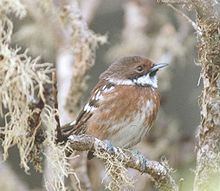Subclass Neornithes Superorder Neoaves Scientific name Chasiempis sandwichensis Rank Species | Phylum Chordata Infraclass Neognathae Order Passeriformes Higher classification ‘Elepaio | |
 | ||
Similar ‘Elepaio, Bird, O'ahu ʻelepaio, Kauaʻi ʻelepaio, Monarch flycatcher | ||
The Hawaiʻi ʻelepaio (Chasiempis sandwichensis), also Hawaiian ʻelepaio, is a monarch flycatcher found on the Big Island of Hawaii. Until 2010, all three ʻelepaio species, the Kauaʻi ʻelepaio (C. sclateri), the Oʻahu ʻelepaio (C. ibidis) and this species were considered conspecific.
Contents
Taxonomy and systematics
The Hawaiʻi ʻelepaio was originally classified in the genus Muscicapa.
Subspecies
The three subspecies on the Big Island differ in their ecological requirements and head coloration (see also Gloger's Rule):
References
Hawaiʻi ʻelepaio Wikipedia(Text) CC BY-SA
